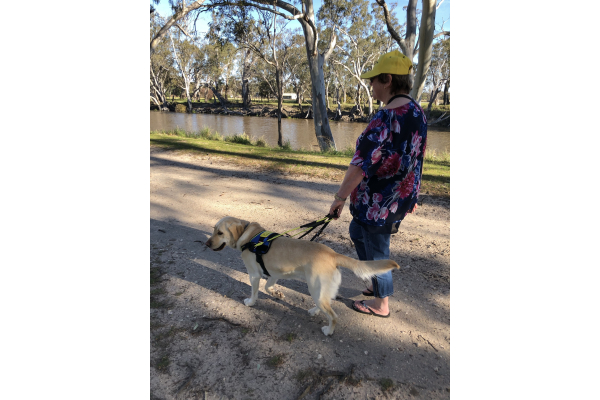Living with some medical conditions in the rural areas can be a challenge, and the minute Alison Hall had to hand in her licence, her world in the Wimmera got very small.
Living on a farm north of Dimboola, where distances were only achievable with four wheels, Alison could not fathom the prospect of life with blindness.
Without the option of driving, a move into town was inevitable.
Alison, 66, lives with retinitis pigmentosa, a degenerative eye condition that causes tunnel vision. It affects peripheral vision, so judging steps or curbs can be difficult.
With her husband away for extended periods as an interstate train driver and her children all grown up and moved out from family home, Alison knew she would have to learn new skills to keep her independence.
A breakthrough came when she was matched with her first Seeing Eye Dog Dougal.
“Before getting Dougal, I struggled with confidence more than anything, and trusting my ability to cross the road,” she said.
“I had to rely on myself and a white cane to get myself places. I trust the dogs more than I trust my cane.”
Above - Alison with her new Seeing Eye Dog Enid, and retired Seeing Eye Dog golden retriever Dougal.
Alison and Dougal became popular figures in the Dimboola shops and neighbourhood, but now locals are spotting a new companion on her left side, Enid.
“Enid is my second Seeing Eye Dog,” Alison said.
“She keeps me active; it’s been really good, to be honest. Poor Dougal slowed down in his old age.”
Dougal is now living out his well-deserved retirement after close to a decade of service and Dougal and Enid have quite acute dynamic.
“I was concerned that they might not get along, but they’re happy to snuggle up together in the sun through the window. Half of the time they sleep on the same bed. They’re almost like siblings.”
Enid’s introduction has meant Alison can continue to live a rich, independent life.
“It means I can walk out my front gate and go for a walk without checking with my husband that he’s available. I don’t have to rely on somebody.”
It takes up to two years and more than $50,000 to train one Seeing Eye Dog, and their average working life is eight years before they retire.
They provide a vital service to people who are blind or have low vision, keeping them safe, spotting obstacles and being their eyes.
More information about Seeing Eye Dogs can be found on Vision Australia’s website.

Alison with her new Seeing Eye Dog Enid going for a walk.
|





